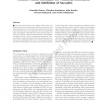Free Online Productivity Tools
i2Speak
i2Symbol
i2OCR
iTex2Img
iWeb2Print
iWeb2Shot
i2Type
iPdf2Split
iPdf2Merge
i2Bopomofo
i2Arabic
i2Style
i2Image
i2PDF
iLatex2Rtf
Sci2ools
JOCN
2010
2010
Distinct Neural Correlates for Volitional Generation and Inhibition of Saccades
■ The antisaccade task has proven highly useful in basic and clinical neuroscience, and the neural structures involved are well documented. However, the specific neurocognitive functions and their interactions are not yet understood. An event-related fMRI study was designed to dissociate the neural correlates of two putative key functions, volitional saccade generation and inhibition of reflexive saccades, and to investigate their interaction. Nineteen healthy volunteers performed a task that required (a) to initiate saccades volitionally, either with or without a simultaneous demand to inhibit a reflexive saccade; and (b) to inhibit a reflexive saccade, either with or without a simultaneous demand to initiate a saccade volitionally. Analysis of blood oxygen level-dependent signal changes confirmed a major role of the frontal eye fields and the supplementary eye fields in volitional saccade generation. Inhibition-related activation of a specific fronto-parietal network was highly co...
| Added | 28 Jan 2011 |
| Updated | 28 Jan 2011 |
| Type | Journal |
| Year | 2010 |
| Where | JOCN |
| Authors | Benedikt Reuter, Christian Kaufmann, Julia Bender, Thomas Pinkpank, Norbert Kathmann |
Comments (0)

